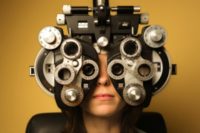A National Institutes of Health (NIH) study found that although 94 percent of Americans aged 12 and older have good vision, the remaining six percent, or 14 million, are visually impaired.
Of these, more than 11 million have uncorrected visual impairment, such as nearsightedness. They need eyeglasses or contact lenses to improve their vision. Teenagers, people with diabetes, Hispanics, and people who are economically disadvantaged have higher rates of visual impairment and can most benefit from corrective lenses.
The study, designed and supported by the National Eye Institute (NEI) of the NIH, was part of the National Health and Nutrition Examination Survey, an ongoing survey conducted by the National Center for Health Statistics of the Centers for Disease Control and Prevention. More than 15,000 people participated in the survey from 1999 to 2002. They were interviewed in their homes and were invited to undergo a comprehensive health examination in a mobile examination center (MEC). More than 14,000 reported to a MEC, and more than 13,000 completed visual acuity tests.
The study found that most people who have a visual impairment could achieve good vision with proper eyeglasses or contact lenses. If you have trouble seeing, you should get your eyes examined as soon as possible. Ct corrective lenses may improve your vision. If you do have an eye disease, the sooner it is found, the more likely it is that treatment can help preserve your vision.
The study authors made the following recommendations:
- Health care professionals should talk to their patients about the importance of eye health and encourage them to participate in routine vision screenings and eye examinations.
- People who already wear eyeglasses or contact lenses should return to their eye care professional for periodic eye examinations.
- Efforts to increase public awareness about the importance of routine eye examinations should be undertaken.
- Vision screening opportunities for the public should be expanded.
Source: NIH





